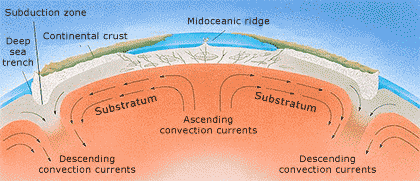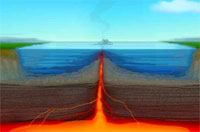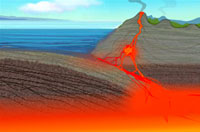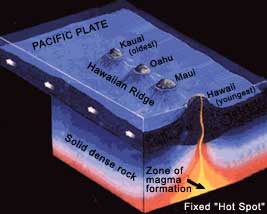Volcano Formation
|
This schematic cross section of convection and tectonic plates shows how new crust is generated at a mid-oceanic ridge. |
Diverging Plates
Almost all of the areas where the plates are spreading apart occur beneath the oceans, at mid-oceanic ridges. In these locations, very hot rock comes up through a rift in the crust to the ocean floor. Some of the lava produced at an underwater rift is called pillow lava because of its lumpy shape. It emerges in blobs, with crusts that quickly harden. As the lava oozes down the sides of the undersea volcano, hot magma inside the pillow pops out to form a new pillow. Layers of pillow lava build up and then finally cool down completely and solidify into a new crust made of basalt. This explains why the rocks at the bottom of the ocean are young compared with continental rocks.
|
|
Over millions of years, layer upon layer of this fresh crust has built up on the ocean floor to form a long chain of mountainous volcanoes. Sometimes the tops of the volcanoes rise above the surface of the ocean, forming an island such as Iceland. Iceland straddles the Mid-Atlantic rift, which zigzags along the ocean floor from the Arctic to nearly the Antarctic, between the Eurasian and North American plates in the northern Atlantic, and the African and South American plates in the southern Atlantic.
These rifts also sprout up volcanic hot springs called hydrothermal vents and nicknamed black smokers. Discovered in 1977, they are undersea cousins to the hot springs at calderas such as Yellowstone. They form when underground seawater heats up and rises through vents in a fresh lava floor. The water dissolves and carries with it acidic sulfides of copper, lead, and zinc, which build up into black pipe-like chimneys.
Subduction Zones
When plates move toward each other, a continental plate rides over the top of an oceanic plate. It never happens the other way around, because oceanic plates are heavier and thinner, at 2 to 10 km (1 to 6 mi), than continental plates, at 20 to 40 km (12 to 25 mi). The heavier oceanic plates are composed of a greater portion of dense material, including the fine-grained basalts spewed from undersea volcanoes and heavy metals such as iron. Continental plates, in comparison, are mostly coarse granites, which contain a lot of light elements (silicon, aluminum, and sodium, to name three).
As the cold oceanic crust descends, it’s heated by the underlying hot mantle and by the friction caused by the plates moving against each other. This edge of the ocean floor is older than the fresh floor near the mid-ocean rift and so, over millions of years, thick layers of sediment have been laid on top of it. This sediment includes sand and mud from rivers and fragments of shells from sea creatures. The descending plate carries these sediments to the hot mantle, where they melt to create a new kind of magma that cools into rocks called andesite. The magma is named after the Andes mountains of South America, where a subduction zone has created some of the most stunning, towering, snowcapped volcanoes on the Earth. Andesitic magma often intrudes through cracks in the continental crust to the surface, causing violent volcanic eruptions.
|
|
Illustration courtesy of USGS. The zone of magma formation, or hot spot, is well below the shifting tectonic plates and doesn’t budge. For reasons not fully understood, occasional plumes of magma punch through the crust to form a volcanic island. During the long intervals between plumes, the island cruises away on its continental raft. The next plume rises and creates a new volcanic island.` |
|
Scientists think that Yellowstone’s caldera, with all its volcanic features, was created when the rock around the center of the volcano fractured in a ring pattern. The volcano exploded and the center collapsed, leaving a crater. |
|
|
A hot spot powers Piton de la Fournaise, a shield volcano on Réunion Island in the Indian Ocean. |
|
Hot Spots
The existence of hot spots is probably one of the most controversial points in plate tectonics. The hot spot theory suggests that an unusual event at a point inside the Earth forces a column of magma to go up to the surface. The magma always rises at the same place, but it arrives at random intervals of time. As the oceanic crust moves over the fixed hot spot, the lava surfaces at a different place on the crust.
For example, the Hawaiian island chain follows the general movement of the oceanic crust. According to the hot spot theory, each island was created in turn by intense volcanic activity, followed by a long period of silence. A point in favor of this explanation is the pattern of volcanic activity of the islands. Only the Big Island of Hawaii, the youngest island in the archipelago, still has active volcanoes.
The ancient caldera of Yellowstone sits on a continental hot spot, where a magma plume has melted away granitic crust.
What causes the hot spots? Again, there are several theories. No single theory is definitely correct. One that is widely accepted credits convection currents in the asthenosphere—the semisolid layer of the mantle beneath the lithosphere. On a much larger scale, these currents move around within the enormous amount of rock in the mantle, causing tectonic plates to move. Hot spots are believed to be caused by a similar convection-current scenario, but on a local scale. Their turmoil creates a weak area in the lithosphere, allowing magma to break through to the surface and create a volcano.
Why doesn’t this happen all the time? Why does volcanic activity stop for a while and then start up again? These questions are still part of the mystery of hot spots.
Although volcanoes occur in most places around the world, many are concentrated in one area: the rim of the Pacific Ocean. This region, known as the Ring of Fire, is famous for all kinds of tectonic activity.
This content has been re-published with permission from SEED. Copyright © 2024 Schlumberger Excellence in Education Development (SEED), Inc.








